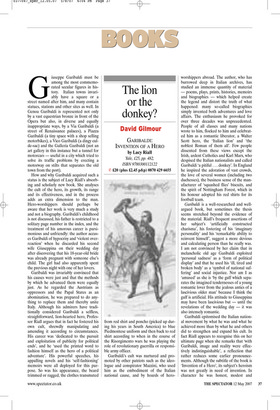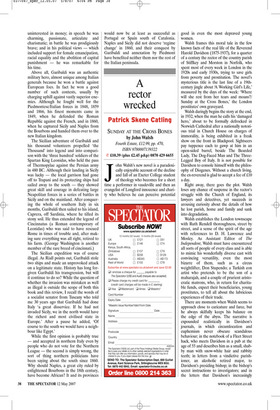The lion or the donkey?
David Gilmour
GARIBALDI: INVENTION OF A HERO by Lucy Riall Yale, £25, pp. 482, ISBN 9780300112122 ✆ £20 (plus £2.45 p&p) 0870 429 6655 Giuseppe Garibaldi must be among the most commemorated secular figures in history. Italian towns invariably have a square or a street named after him, and many contain statues, stations and other sites as well. In Genoa Garibaldi is represented not only by a vast equestrian bronze in front of the Opera but also, in diverse and equally inappropriate ways, by a Via Garibaldi (a street of Renaissance palaces), a Piazza Garibaldi (a tiny space with a shop selling motorbikes), a Vico Garibaldi (a dingy culde-sac) and the Galleria Garibaldi (not an art gallery in this instance but a tunnel for motorcars — useful in a city which tried to solve its traffic problems by erecting a motorway on stilts that separates the old town from the port).
How and why Garibaldi acquired such a status is the subject of Lucy Riall’s absorbing and scholarly new book. She analyses the cult of the hero, its growth, its range and its effectiveness, and in the process adds an extra dimension to the man. Hero-worshippers should perhaps be aware that her work is very much a study and not a biography. Garibaldi’s childhood is not discussed, his father is restricted to a solitary page number in the index, and the treatment of his amorous career is parsimonious and unfriendly: the author accuses Garibaldi of hypocrisy and ‘violent overreaction’ when he discarded his second wife Giuseppina on their wedding day after discovering that his 18-year-old bride was already pregnant with someone else’s child. The girl had also apparently spent the previous night with one of her lovers.
Garibaldi was invariably convinced that his causes were just and that the methods by which he advanced them were equally just. As he regarded the Austrians as oppressors and the Papal States as an abomination, he was prepared to do anything to replace them and thereby unite Italy. Although his admirers have traditionally considered Garibaldi a selfless, straightforward, lion-hearted hero, Professor Riall argues that in fact he fostered his own cult, shrewdly manipulating and amending it according to circumstances. His career was ‘dedicated to the pursuit and exploitation of publicity for political ends’, and he ‘used the printed word to fashion himself as the hero of a political adventure’. His powerful speeches, his appalling novels and his ‘self-fashioning’ memoirs were all deployed for this purpose. So was his appearance, the beard trimmed or ragged, the clothes transmuted from red shirt and poncho (picked up during his years in South America) to blue Piedmontese uniform and then back to red shirt according to when in the course of the Risorgimento wars he was playing the role of revolutionary guerrilla or responsible army officer.
Garibaldi’s cult was nurtured and promoted by other patriots such as the ideologue and conspirator Mazzini, who used him as the embodiment of the Italian national cause, and by hoards of hero worshippers abroad. The author, who has burrowed deep in Italian archives, has studied an immense quantity of material — poems, plays, prints, histories, memoirs and biographies — which helped create the legend and distort the truth of what happened: many so-called biographies simply invented both adventures and love affairs. The enthusiasm he provoked for over three decades was unprecedented. People of all classes and many nations wrote to him, flocked to him and celebrated him as a romantic liberator, a Walter Scott hero, the ‘Italian lion’ and ‘the noblest Roman of them all’. Few people dissented from these views except the Irish, ardent Catholics and Karl Marx, who despised the Italian nationalists and called Garibaldi ‘a pitiful . . . donkey’. In England he inspired the adoration of vast crowds, the love of several women (including two duchesses), the business sense of the manufacturer of ‘squashed flies’ biscuits, and the spirit of Nottingham Forest, which in his honour adopted his red shirts for its football team.
Garibaldi is a well-researched and wellargued book, but sometimes the thesis seems stretched beyond the evidence of the material. Riall’s frequent assertions of her subject’s ‘artificially constructed charisma’, his fostering of his ‘imaginary personality’ and his ‘remarkable ability to reinvent himself’, suggest a more devious and calculating person than he really was. I am not convinced by her claim that in melancholic old age Garibaldi exploited ‘personal sadness’ as a ‘form of political display’ and that he used his ‘ill, tired and broken body’ as a ‘symbol of national suffering’ and social injustice. Nor am I as ‘amused’ as she is ‘by the gulf which separates the imagined tendernesses of a young romantic lover from the jealous antics of a lascivious older man’ because I think the gulf is artificial. His attitude to Giuseppina may have been lascivious but — until the revelations of the wedding day — it was also intensely romantic.
Garibaldi epitomised the Italian national movement by what he was and what he achieved more than by what he and others did to strengthen and expand his cult. In fact Riall appears to recognise this on her ultimate page when she remarks that ‘with Garibaldi, image and reality were effectively indistinguishable’, a reflection that rather reduces some earlier pronouncements. Although the subtitle of the book is ‘Invention of a Hero’, its subject’s heroism was not greatly in need of invention. In character he was honest, modest and uninterested in money; in speech he was charming, passionate, articulate and charismatic; in battle he was prodigiously brave; and in his political views — which included support for female emancipation, racial equality and the abolition of capital punishment — he was remarkable for his time.
Above all, Garibaldi was an authentic military hero, almost unique among Italian generals because he won a battle against European foes. In fact he won a good number of such contests, usually by charging uphill against vastly superior enemies. Although he fought well for the Piedmontese/Italian forces in 1848, 1859 and 1866, his finest moments came in 1849, when he defended the Roman Republic against the French, and in 1860, when he captured Sicily and Naples from the Bourbons and handed them over to the new Italian kingdom.
The Sicilian adventure of Garibaldi and his thousand volunteers propelled ‘the Thousand’ into legend and into comparison with the ‘three hundred’ soldiers of the Spartan King Leonidas, who held the pass of Thermopylae against the Persian army in 480 BC. Although their landing in Sicily was lucky — the local garrison had gone off to Trapani and its protecting ships had sailed away to the south — they showed great skill and courage in defeating large Neapolitan forces in a series of battles in Sicily and on the mainland. After conquering the whole of southern Italy in six months, Garibaldi then sailed to his island, Caprera, off Sardinia, where he tilled its stony soil. He thus extended the legend of Cincinnatus (a Roman contemporary of Leonidas) who was said to have rescued Rome in times of trouble and, after making sure everything was all right, retired to his farm. (George Washington is another member of the rare breed of cincinnati.) The Sicilian expedition was of course illegal. As Riall points out, Garibaldi stole two ships and made an unprovoked attack on a legitimate state. History has long forgiven Garibaldi his transgression, but will it continue to do so? While the question of whether the invasion was mistaken as well as illegal is outside the scope of both this book and this review, I recall the words of a socialist senator from Tuscany who told me 30 years ago that Garibaldi had done Italy ‘a great disservice. If he had not invaded Sicily, we in the north would have the richest and most civilised state in Europe.’ After a pause he added, ‘Of course to the south we would have a neighbour like Egypt.’ While the first opinion is probably true — and accepted in northern Italy even by people who do not vote for the Northern League — the second is simply wrong, the sort of thing northern politicians have been saying about the south since 1860. Why should Naples, a great city ruled by enlightened Bourbons in the 18th century, have become African? It and its provinces would now be at least as successful as Portugal or Spain south of Catalonia. Naples and Sicily did not deserve ‘regime change’ in 1860, and their conquest by Garibaldi and annexation by Piedmont have benefited neither them nor the rest of the Italian peninsula.











































































 Previous page
Previous page